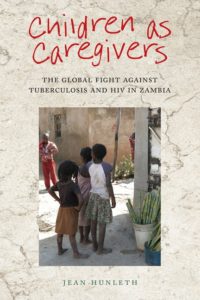Reviewed Book
Children as Caregivers: The Global Fight against Tuberculosis and HIV in Zambia. Jean Hunleth, Rutgers University Press, 2017, 224 pp.

How do children make sense of global health care? How are global health care projects and strategies transformed by children? These are two of the primary questions that frame Jean Hunleth’s impressive ethnography, Children as Caregivers: The Global Fight Against Tuberculosis and HIV in Zambia. Based on nearly 10 years (2005–2014) of in-depth fieldwork on tuberculosis (TB) and HIV programs in Zambia’s capital city of Lusaka, Hunleth vividly demonstrates for readers how an analytic focus on children in health care provides robust insights into the machinations of globalization and local family politics in vulnerable contexts entrenched in structural violence.
While scholarship on childhood in anthropology has revealed, for decades now, the central role young people play in global capitalism and neoliberal processes, Hunleth reminds us that, particularly in Africa, children have been curiously absent in the critical study of global health. The main contributions of the book help fill this gap in medical anthropological literature. Through richly textured daily scenes that depict children’s practices of intergenerational medical care, and through interviews that capture children’s voices, Hunleth substantially extends our understandings of how infectious disease shapes everyday life for children in local communities.
Hunleth’s arguments in Children as Caregivers are three-fold. First, she asserts in the start of the book that global health care processes do not only impact children, they are shaped by children, especially those who care for sick guardians in what she terms, “low to middle income countries” (p. 4). Next, by focusing on the complexities of children’s everyday relationships, Hunleth challenges global humanitarian depictions of “the child” in settings with high rates of infectious disease. These depictions typically frame children as “lost or isolated,” and represent them through categories such as “the orphan” or “the street child.” We come to think about children in vulnerable contexts through these “scripts,” which are, she suggests, limited, if not dangerous” (p. 4).
However, Hunleth’s research contextualizes children’s grounded lives to reveal a set of fuller, richer revelations. These human relations entail an interdependence that sick adults have for children in their households—indeed, in many instances in TB- or HIV- affected households, children are important caregivers in their own right. Finally, Henleth demonstrates how children are social actors who shape biomedical systems of knowledge that were designed exclusively for adults. Given their exclusion from such knowledge, it is crucial, Hunleth contends, for health care policymakers to recognize their experiences and circumstances if more effective policies are to be developed.
Woven into every chapter of the book is Hunleth’s key ethnographic finding: Children strive to get closer to sick relatives. In Chapter 1, we learn about what it is like to grow up in George, the poor urban area of Lusaka where the research took place. The history Hunleth provides here uncovers decades of structural transformations beginning in the 1960s after Zambia’s independence from the British and leading up to the presen. These processes included rural to urban resettlement and structural adjustment programs—all of which have, over time, made life poorer and more difficult for residents in George. The chapter lays the contextual groundwork for how children experience their environment and social worlds within it. The remainder of the book delineates in deeper ethnographic detail children’s perspectives and practices with medical care. Chapters 2–5 focus on the interdependence between children and adults and the ways in which children maximized proximity and nurturance as they care for guardians. We hear directly from children like Annie (p. 92), who holds her mother’s hand while her mother vomits, chats with her, eats in separate bowls to limit infection, and gives her mother the daily medication she needs. We also come to understand the emotional implications these realities have on children as they carry out the work of care, such as living with uncertainty and possessing detailed knowledge of disease (pp. 98–99). In addition, we observe how children like Musa and Rhoda (p. 113) learn to “follow the medication” and adhere to particular pharmaceutical regimens provided by the national government for their infected guardians. Children’s domestic contributions and responsibilities are rendered visible in these chapters, as Hunleth captures how gendered caregiving practices within households affected by epidemics are structured around children (p. 127).
In the conclusion, Hunleth masterfully calls for a re-theorization of children’s place in global health care policy, stating that, “children’s perspectives are needed for a fuller understanding of global health problems” (p. 146). We must think of children not through the overly simplistic category of victim, she argues, but rather as agents of health who dedicate their efforts to maintaining dignity and sustaining lives (p. 150).
Beyond these groundbreaking theoretical findings, the strength of Children as Caregivers lies in its diverse methodology and forms of evidence. Hunleth draws on personal experience as a Peace Corp fieldworker and anthropologist. She conducted in-depth observations in 25 households and incorporated interviews with children aged 8–12 years old. In addition, a broad survey of 200 households in George was conducted, giving the study impressive statistical breadth. Participatory workshops with children were conducted, and children’s own sketches and drawings are included. These images animate the book and give readers a glimpse into how children envisage and represent their social worlds through art.
Children as Caregivers is a rare and timely ethnographic study of childhood and illness. Readers interested in expanding their knowledge of critical global health, infectious disease, and kinship politics will find tremendous value in this book. As a testament to ethnography’s value in the social sciences, Children as Caregivers provides researchers with new, creative methods on how to capture children’s voices and experiences, in all their complexity.